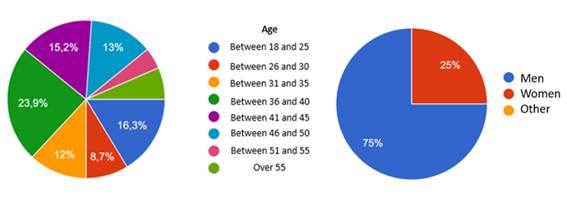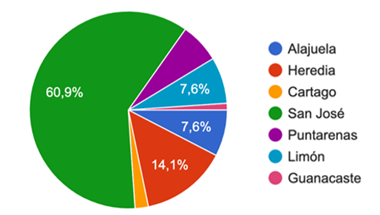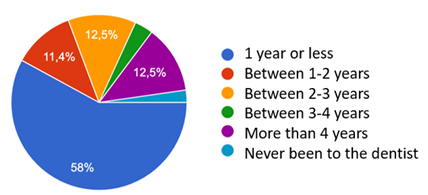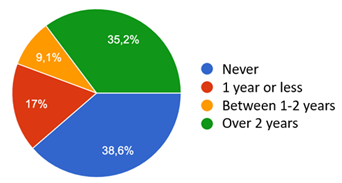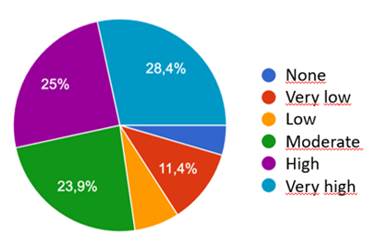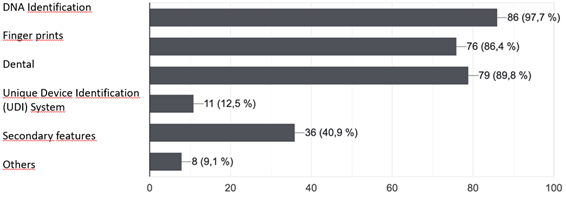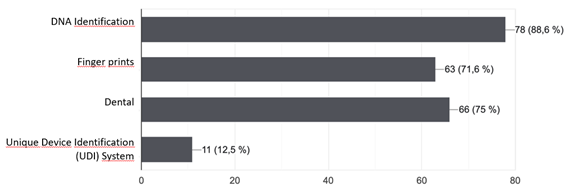Serviços Personalizados
Journal
Artigo
Indicadores
-
 Citado por SciELO
Citado por SciELO -
 Acessos
Acessos
Links relacionados
-
 Similares em
SciELO
Similares em
SciELO
Compartilhar
Medicina Legal de Costa Rica
versão On-line ISSN 2215-5287versão impressa ISSN 1409-0015
Med. leg. Costa Rica vol.40 no.2 Heredia Set./Dez. 2023
Original research
Perception of the usefulness of dental records as a method of human identification in high-risk professions: the case of the Costa Rican Red Cross workers
1. Espec. Odontología Forense. Patología y Cirugía Oral. M.Sc. Administración de Servicios de Salud Sostenible. Profesor Facultad de Odontología Universidad de Costa Rica. Unidad de Odontología Forense, Departamento de Medicina Legal, Organismo de Investigación Judicial. Heredia, Costa Rica. ORCID ID: https://orcid.org/0000-0001-6478-5407
Introduction:
Those who provide care in emergency situations are exposed to a high risk of injury or death during rescue work, whether in traffic accidents, natural disasters, terrorist attacks, or humanitarian crises generated by armed conflicts. This research was carried out among Costa Rican Red Cross (CRC) workers to establish the perception of the usefulness of dental records as a method of identification and to develop a single format for antemortem dental information.
Materials and methods:
A pilot questionnaire was designed and applied to 10 persons to be calibrated and validated. Subsequently, a final electronic questionnaire was generated in the Google Forms platform and sent via institutional e-mail to 175 workers, of whom 92 responded during the period from November 20, 2022, to January 20, 2023. The results were analyzed by means of frequency distributions, crossing of variables, and comparison of means based on the analysis of variance. The minimum confidence level for comparisons was 95%.
Results:
The questionnaire was completed by 92 people, 75% men and 25% women. The age range between 36 and 40 years was the most frequent (23.9%). A total of 60.9% worked in the province of San José, 58% indicated that they had visited the dentist a year ago or less and 38.6% said that they had never had a panoramic X-ray taken, 81.8% said they had dental treatments such as crowns, bridges or implants; and 75% considered dental records to be very useful as a method of identification, and placed it in second place in terms of knowledge (89.8%) when compared with DNA (97.7%) and dactyloscopy (86.4%).
Conclusions:
Costa Rican Red Cross workers consider dental records to be useful in the identification of human beings and have useful antemortem information for this purpose.
Key words : Red Cross; identification; dental records; perception; occupational risk
Introduction
Red Cross personnel attend all types of emergencies ranging from traffic accidents, natural disasters, terrorist attacks, disappearances, humanitarian crises and any other incident where lives are at risk.(1) Within the fields where Red Cross personnel work are humanitarian crises generated by internal armed conflicts or wars, where it is frequent that personnel suffer direct attacks or are part of the collateral damage as humanitarian workers (2), in some cases even political situations can generate what is known as "complex emergencies".(3)
In Costa Rica during the year 2022, more than half a million Red Cross responses were made, which included aggressions, water accidents, collisions, mountain searches and others that generated 255 more deaths than in 2021.(4)
A lifeguard can die during everyday events, for example during the care of a traffic accident because of other drivers who do not realize that an accident has occurred.(5) In our country there are few documented cases of the murder of Red Cross workers, the most famous one occurred on December 21, 1948 and had a political tinge where six volunteers were killed.(6)
Internationally, the historical event with the highest number of first responder deaths in a single event was the attack on the World Trade Center (WTC) on September 11, 2001, which resulted in the deaths of 2,749 people, of whom approximately 421 were members of rescue corps (7-9).
Due to the high risk with which lifeguards live daily, it is important to have adequate antemortem dental data that allow reliable identification, these data can reduce the wait for an identification from months to a few hours, while on the other hand if the antemortem dental information is inaccurate it can generate confusion, delays and finally make it necessary to use more complex methods such as DNA, This can easily be avoided by being careful when writing down information in the dental record.(10)
There are no specific antemortem information forms in Costa Rica for high-risk personnel such as firefighters, criminal investigators or any other rescue corps for investigative purposes.(11)(12)
Materials and methods
A summary of the research project containing the general objective, specific objectives, as well as the justification and possible benefits for the organization, was presented to the Head of the Department of Emergency Response and Rescue of the Costa Rican Red Cross; In addition, the pilot questionnaire reviewed by a statistician was attached to the document.
After obtaining authorization to initiate the investigation, the pilot questionnaire was applied to 10 people and corrected and recalibrated to be sent to staff.
The final questionnaire was designed on the Google Forms platform and sent via institutional mail to 175 Red Cross workers.
The questionnaire included a header with a brief description of the project along with a consent and anonymity clause, as well as the possibility to complete only the general data; it was online from November 20, 2022 to January 20, 2023.
The results were analyzed by frequency distributions, crossing of variables, comparison of means based on the analysis of variance. The minimum confidence level for comparisons was 95%. The bibliographic review used in this research was carried out through different virtual platforms such as Medline, Scielo and PubMed.
Results
The questionnaire was carried out by 92 people, of whom 88 answered the complete questionnaire (95.7% of the sample), the remaining 4.3% only completed the sociodemographic data.
Age and gender
Regarding sex, 75% are men and 25% women, representing a ratio of 3:1. The most common age range was between 36 and 40 years with no statistically significant difference found in the average age of men
Marital status
About marital status, it is observed that 39.1% indicated being single, followed by 22.6% married and 15.2% in free union, the lowest percentage corresponds to divorced persons (13%) and in the sample there were no people in widowhood condition.
Distribution by provinces
Most of the personnel works in San José (60.9%), in second place, 14.1% in Guanacaste, then Limón, Alajuela and Heredia (7.6%) and the smallest number of people surveyed (2.2%) work in the province of Cartago.
Dental treatments and periodicity
More than half of respondents mentioned that they received dental treatment 1 year ago or less (58%), in contrast to 2.3% who have never attended dental consultation. An 88.1% claim to have dental treatments such as restorations (composites), crowns, bridges, or implants.
About performing of x-rays, 38.6% indicate that they have never had a panoramic X-ray, 17% say they had one a year ago or less, 9.1% between 1 and 2 years and finally 35.2% more than two years ago.
Risk perception
In relation to the perception of risk of their work, 28.4% perceive that it is very high, 25% high and 23.9% moderate. Only 11.4% consider the risk to be very low and 4.5% describe it as null as shown in Figure 7.
Methods of identification
Regarding knowledge of identification methods, the best known is DNA (97.7%) followed by the dental method (89.8%) and in third place fingerprints (86.4%); It was also the combination of methods with the highest prevalence (Figure 8).
Opinion on identification methods in high-risk professions
When asked which method of identification was most suitable for people with high-risk tasks such as Costa Rican Red Cross personnel, 88.6% answered that DNA in first place, followed by 75% who indicated that identification by dentistry, in third place was identification by dactyloscopy (71.6%).
Employment status, accident rate and training
According to the answers obtained, 30.7% are part of the Red Cross in a paid manner, that is, 69.3% of the sample are volunteers, on the other hand 83% indicated that the functions they perform require specialized training to reduce risks and 43.2% said they had suffered an accident or situation that put their lives at risk. Finally, 93.2% answered that they would like to be taken into account for the creation of an antemortem database for identification purposes.
Discussion
When examining the distribution by provinces of the Red Cross workers surveyed, it is observed that most of them are concentrated in San José (GAM), especially in San José where more than sixty percent of the sample (60.9%) is concentrated and in general terms more than 90% are working in the Greater Metropolitan Area (GAM) these data are similar to those obtained in research previously carried out in other professions of high risk in Costa Rica as firefighters and investigators of the Judicial Investigation Agency (OIJ). (11)(12)
Regarding sex, it is interesting that of the sample surveyed 75% were men, in contrast to the staff of the Red Cross in the United States of America where 68% of the staff is female. On the other hand with respect to the age of the personnel in the U.S. the oldest range is between 20 and 30 years while in Costa Rica it is between 30 and 40 years.(13)
It is extremely important to highlight that with respect to knowledge and opinion about which method they consider to be appropriate for the identification of Red Cross personnel, dentistry ranked second in both questions while in previous studies in firefighters and researchers it ranked third. (11)(12)
58% of respondents responded that they received dental treatment 1 year ago or less and this coincides with surveys of firefighters and researchers (in both more than 50% received dental treatment a year ago or less) and also in the three groups more than 60% if they have had panoramic x-rays at some point in their lives. (11)(12)
This is vitally important in terms of identifying cadavers or skeletal remains. (14)(15)
One aspect that should be mentioned is the perception of risk, since as in firefighters and researchers it was considered very high by most of the sample.
Finally, treatments and dental characteristics are vital as a means of identification, however their usefulness is subject to the existence of antemortem records with faithful information, ideally with radiological images and photographs. The possibility of identifying corpses in a state of putrefaction or carbonization is thanks to the resistance of the dental structures that provide us with a large amount of information. (20-26)
Although in forensic dentistry there are techniques such as Cheiloscopy and Palatoscopy, these are of very little use in terms of identification when the soft tissues are already altered due to putrefaction or the conditions of death of the individual. (27-32).
At this time dentistry is increasingly digital and radiological images are easily stored that together with the odontogram provide enough information for identification purposes. (34)
Conclusions
According to the data obtained by Red Cross workers, these personnel are interested in being part of a database that allows them to be identified if necessary, through dental characteristics.
A large majority attend dental consultations regularly and have clinical records that include panoramic x-rays.
No protocols were found in the literature where to collect antemortem information from personnel who are exposed to high occupational risk, this condition is not unique to Costa Rica since there is nothing at the international level that is approved by any institution, for this reason implementing a format for identification purposes is a necessity.
Bibliografía
1. Reichard AA, Jackson LL. Occupational injuries among emergency responders. Am J Ind Med (Internet). 2010 Jan 1 (cited 2022 Jan 27);53(1):1-11. Available from: https://onlinelibrary-wiley-com.ezproxy.sibdi.ucr.ac.cr/doi/full/10.1002/ajim.20772 [ Links ]
2. Sheik M, Gutierrez MI, Bolton P, Spiegel P, Thieren M, Burnham G. Deaths among humanitarian workers. BMJ Br Med J (Internet). 2000 Jul 7 (cited 2023 Apr 29);321(7254):166. Available from: /pmc/articles/PMC1118167/ [ Links ]
3. Frederick M Burkle J. Fortnightly review: Lessons learnt and future expectations of complex emergencies. BMJ Br Med J (Internet). 1999 Aug 8 (cited 2023 Apr 29);319(7207):422. Available from: /pmc/articles/PMC1127041/ [ Links ]
4. El año 2022 concluye con más de medio millón de respuestas atendidas por Cruz Roja Costarricense - Cruz Roja (Internet). (cited 2023 May 1). Available from: https://cruzroja.or.cr/el-ano-2022-concluye-con-mas-de-medio-millon-de-respuestas-atendidas-por-cruz-roja-costarricense/ [ Links ]
5. (VIDEO) Cruz Roja hará homenaje de despedida a socorrista muerto en Ochomogo (Internet). (cited 2023 May 1). Available from: https://www.crhoy.com/nacionales/video-cruz-roja-hara-homenaje-de-despedida-a-socorrista-muerto-en-ochomogo/ [ Links ]
6. “Caínes despiadados… Caínes invasores” - EL ASESINATO DE LOS VOLUNTARIOS DE LA CRUZ ROJA - El Espíritu del 48 (Internet). (cited 2023 May 1). Available from: https://elespiritudel48.org/caines-despiadados-caines-invasores/5/ [ Links ]
7. Lawson JR, Vettori RL. Federal Building and Fire Safety Investigation of the World Trade Center Disaster The Emergency Response Operations (Draft) For Public Comment. [ Links ]
8. NFPA statistics - Firefighter deaths (Internet). (cited 2021 Mar 4). Available from: https://www.nfpa.org/News-and-Research/Data-research-and-tools/Emergency-Responders/Firefighter-fatalities-in-the-United-States/Firefighter-deaths [ Links ]
9. FDNY Fire Operations response on September 11. [ Links ]
10. Lorkiewicz-Muszyńska D, Przystańska A, Glapiński M, Kociemba W, Zaba C. Difficulties in personal identification caused by unreliable dental records. J Forensic Leg Med. 2013;20(8):1135-8. [ Links ]
11. Fernández Chaves JM. Perception of the usefulness of dental records as a method of human identification in high-riskprofessions: the case of the Costa Rican firefighters. Med Leg Costa Rica (Internet). 2021 (cited 2021 Mar 19);38(1):146-56. Available from: http://www.scielo.sa.cr/scielo.php?script=sci_arttext&pid=S1409-00152021000100146&lng=en&nrm=iso&tlng=es [ Links ]
12. Manuel Fernández Chaves J, Sc José Manuel Fernández Chaves -- M. Perception of the usefulness of dental records as a method of human identification in high-risk professions: the case of the OIJ investigators. Rev Med Leg Costa Rica (Internet). 2022;39(1):2022. Available from: https://orcid.org/0000-0001-6478-5407 [ Links ]
13. American Red Cross Number of Employees, Statistics, Diversity, Demographics, and Facts - Zippia (Internet). (cited 2023 May 3). Available from: https://www.zippia.com/american-red-cross-careers-53203/demographics/ [ Links ]
14. Vijay Reesu G, Augustine J, Urs AB. Forensic considerations when dealing with incinerated human dental remains. 2014 (cited 2021 Mar 10); Available from: http://dx.doi.org/10.1016/j.jflm.2014.10.006 [ Links ]
15. Woisetschläger M, Lussi A, Persson A, Jackowski C. Fire victim identification by post-mortem dental CT: Radiologic evaluation of restorative materials after exposure to high temperatures. Eur J Radiol. 2011;80:432-40. [ Links ]
16. ZANIN AA, HERRERA LM, MELANI RFH. Civil liability: characterization of the demand for lawsuits against dentists. Braz Oral Res (Internet). 2016 Aug 18 (cited 2021 Sep 2);30(1). Available from: http://www.scielo.br/j/bor/a/8njjNnScdJP6hmQmyZ8Qq5g/?lang=en [ Links ]
17. Vega M J, Bedregal G P, Jadue H L, Delgado B I. Equidad de género en el acceso a la atención de salud en Chile. Rev Med Chil (Internet). 2003 Jun (cited 2021 Sep 2);131(6):669-78. Available from: http://www.scielo.cl/scielo.php?script=sci_arttext&pid=S0034-98872003000600012&lng=es&nrm=iso&tlng=es [ Links ]
18. González Barrón S, Jiménez Corona ME, Triana Estrada J, Ureña Ciret JL, García Hernández J, Carrillo Rocha J de D, et al. Recomendaciones para mejorar la práctica odontológica. Rev CONAMED, ISSN-e 1405-6704, Vol 8, No 1 (Enero-Marzo), 2003, págs 29-38 (Internet). 2003 (cited 2021 Sep 2);8(1):29-38. Available from: https://dialnet.unirioja.es/servlet/articulo?codigo=4052784&info=resumen&idioma=ENG [ Links ]
19. Terada ASSD, de Araujo LG, Flores MRP, da Silva RHA. Responsabilidad Civil del Cirujano-Dentista: Análisis de las Demandas Presentadas en el Municipio de Ribeirão Preto-São Paulo, Brasil. Int J Odontostomatol. 2014 Dec;8(3):365-9. [ Links ]
20. Dineshshankar J, Venkateshwaran R, Vidhya J, Anuradha R, Mary GP, Pradeep R, et al. Denture bar-coding: An innovative technique in forensic dentistry. J Pharm Bioallied Sci (Internet). 2015 Aug 2;7:S350-3. Available from: http://10.0.16.7/0975-7406.163450 [ Links ]
21. Sweet D. Forensic dental identification. (cited 2021 Mar 4); Available from: www.forensicdentistryonline.org/Forensic_pages_1/ident_guidelines.htm. [ Links ]
22. Lain R, Taylor J, Croker S, Craig P, Graham J. Comparative dental anatomy in Disaster Victim Identification: Lessons from the 2009 Victorian Bushfires §. [ Links ]
23. Hanaoka Y, Ueno A, Tsuzuki T, Kajiwara M, Minaguchi K, Sato Y. Proposal for internet-based Digital Dental Chart for personal dental identification in forensics. 2006 (cited 2021 Mar 4); Available from: www.elsevier.com/locate/forsciint [ Links ]
24. Vijay Reesu G, Woodsend B, Mânica S, Revie GF, Brown NL, Mossey PA. Automated Identification from Dental Data (AutoIDD): A new development in digital forensics. 2020 (cited 2021 Mar 4); Available from: http://dx.doi.org/10.1016/j.forsciint.2020.110218 [ Links ]
25. Holobinko A. Forensic human identification in the United States and Canada: A review of the law, admissible techniques, and the legal implications of their application in forensic cases. Forensic Sci Int (Internet). 2012;222(1-3):394. Available from: http://dx.doi.org/10.1016/j.forsciint.2012.06.001 [ Links ]
26. Krishan K, Kanchan T, Garg AK. Dental Evidence in Forensic Identification - An Overview, Methodology and Present Status. Open Dent J (Internet). 2015 (cited 2017 May 5);9:250-6. Available from: https://benthamopen.com/contents/pdf/TODENTJ/TODENTJ-9-250.pdf [ Links ]
27. Fernández Chaves JM. Morphological analysis of palatal rugae pattern in Costa Rican population. Rev Med Leg Costa Rica (Internet). 2020 Sep (cited 2021 Mar 11);37(2):102-14. Available from: https://orcid.org/0000-0001-6478-5407 [ Links ]
28. Fonseca GM, David C, Flórez R. Propuesta de codificicación y análisis de rugosidades palatinas para su aplicaciòn en odontología antropológica y forense. ORAL Rev. 2009;(31):518-23. [ Links ]
29. Saxena S, Aeran H, Rastogi PK, Kadam A. Rugoscopy - An Emerging Aid For Personal Identification - A Review. Indian J Dent Sci (Internet). 2013;5(4):150-3. Available from: https://liverpool.idm.oclc.org/login?url=http://search.ebscohost.com/login.aspx?direct=true&db=ddh&AN=94377191&site=ehost-live&scope=site [ Links ]
30. Selvamani M, Hosallimath S, Madhushankari, Basandi PS, Yamunadevi A. Dimensional and morphological analysis of various rugae patterns in Kerala (South India) sample population: A cross-sectional study. J Nat Sci Biol Med (Internet). 2015 (cited 2017 Apr 16);6(2):306-9. Available from: http://www.ncbi.nlm.nih.gov/pubmed/26283818 [ Links ]
31. Ap I, Gupta M, David M, David MP, Lecturer S. Rugoscopy for Establishing Individuality. IJDA (Internet). 2011 (cited 2017 Apr 16);3(1):427-32. Available from: http://www.rep.nacd.in/ijda/pdf/3.1.427.pdf [ Links ]
32. Mohammed RB, Patil RG, Pammi VR, Sandya MP, Kalyan S V, Anitha A. Rugoscopy: Human Identification by Computer-Assisted Photographic Superimposition Technique. J Forensic Dent Sci (Internet). 2013;5(2):90-5. Available from: http://www.pubmedcentral.nih.gov/articlerender.fcgi?artid=3826049&tool=pmcentrez&rendertype=abstract%5Cnhttp://www.jfds.org/text.asp?2016/8/1/57/176967 [ Links ]
33. Fernández Chaves JM. Utilidad de expedientes odontológicos disponibles en Costa Rica en el año 2018 para la identificación de víctimas de desastres según el protocolo de INTERPOL. Rev Med Leg Costa Rica (Internet). 2019 Mar (cited 2021 Mar 11);36(1):32-42. Available from: https://www.scielo.sa.cr/pdf/mlcr/v36n1/2215-5287-mlcr-36-01-32.pdf [ Links ]
34. Hernández Carazo D, Solano Romero K, Torres Guevara E, Trejos Cisneros JJ, Fernández Chaves JM. Determinación de la simbología más utilizada en expedientes odontológicos en Costa Rica en el año 2019 con fines de identificación de seres humanos. Med leg Costa Rica. 2020;37(1):179-91. [ Links ]
Received: May 01, 2023











 texto em
texto em 


